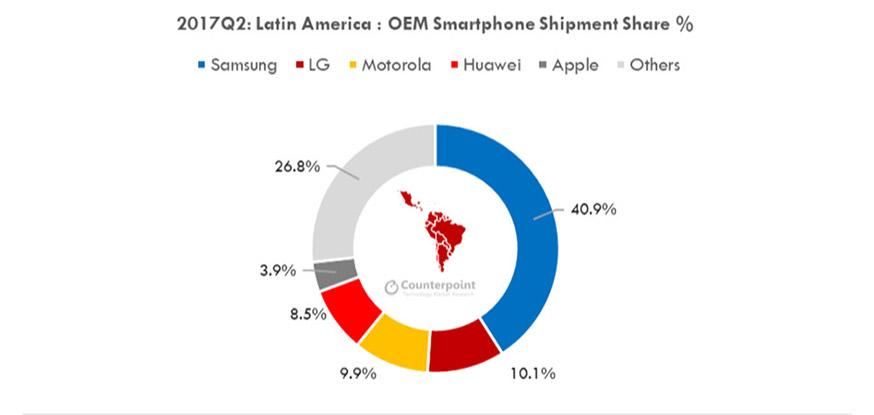Motorola was the fastest growing smartphone brand in South America in Q2 2017, according to the latest research from Counterpoint’s Market Monitor service, while Samsung rose to a healthy and highest ever 41 percent marketshare. Smartphone shipments in the region grew 9 percent annually during Q2 (April-June) driven by improved macroeconomic climate, LTE rollout and open channel growth in some markets.
"Latin America's positive smartphone growth this quarter can be attributed to the uptick in demand in Brazil and Colombia compared to last year despite softness in Peru and Chile," said Counterpoint's Senior Analyst Tina Lu. "Relatively speaking, Q2 2016 last year saw a great dip in demand as the biggest LATAM market, Brazil suffered from a deep recession and low consumer sentiment surrounding the impeachment of former Brazilian president Dilma Rousseff."
According to the World Bank, Brazilian economy is forecasted to grow at a marginal rate of 0.3 percent indicating more stability than last year. Colombia's smartphone market grew 26 percent annually and was the fastest growing market in Q2 2017 due to entry of newer brands such as Meizu, Infinix and Xiaomi expanded the open market, said Lu.
Peru's growth tapered off after a strong growth last year due to aggressive competition between operators, Lu added. Meanwhile, Chile's shipment volumes declined as government cracked down the illegal transshipments to the neighboring countries.
"The other driver of growth has been proliferation of LTE smartphones," Lu said. "Almost nine out of ten smartphones sold in LATAM was LTE capable and instrumental in driving up the replacement rate and feature phone to smartphone upgrade rates. LTE is also allowing some brands to increase their market share as many brands and operators are switching to an all-LTE portfolio of devices."
Commenting on the smartphone OEM competitive environment, Research Analyst, Parv Sharma, noted, "While new Chinese brands have focused on entering and increasing their footprint in LATAM, however, it has been difficult for many of these brands to scale, leverage domestic manufacturing and align well to some of the operator-centric markets in LATAM."
Sharma added, "Unlike in many regions in Asia or Africa, Chinese brands still contribute to only 31 percent of the region's total smartphone volumes. Brazil and Argentina both have local assembly requirements that most Chinese brands struggle to comply with. The exceptions are Lenovo-Motorola and TCL-Alcatel in Argentina and Brazil due to their years of presence in the region and Huawei in Argentina which have invested and partnered for domestic manufacturing to grow in these markets."
Commenting on OEM performances, Senior Analyst, Jene Park highlighted, "Samsung is the king in Latin America and its share is four times higher than its closest competitor, which is LG. On the marketing side, Samsung has capitalized on more than ten years of heavy investment in brand building and an aggressive channel strategy that targeted both the operator and open channels."
Park added, "On the product side Samsung consolidated its advantage in both Brazil and Argentina, which requires local assembly, by exceptional product availability and faster than ever time to market. For example, the Galaxy S8 was launched and available for the Brazilian market just 20 days after the global launch, while the Galaxy S7 took almost 40 days after the global launch."
The Samsung Galaxy J series was the star performer in the LATAM market, according to Counterpoint; however, not the newly refreshed J series, but the 2016 models that were discounted. LG focused on its mid-range K series, especially K4 and K10. This resulted in LG K10 making it to the top five bestselling models in LATAM.
Mr Sharma, noting Motorola's performance highlighted, "Motorola (excluding Lenovo) was the fastest growing brand in LATAM up 65 percent year-on-year in volumes. Biggest boost was Motorola successfully made its way back to America Movil (Claro)'s shelves, which it had not been ranged with for around one year. This win has boosted Motorola's performance not only in Brazil, but also in Colombia and Mexico. Furthermore, Motorola has also been aggressively increasing its open market participation."

